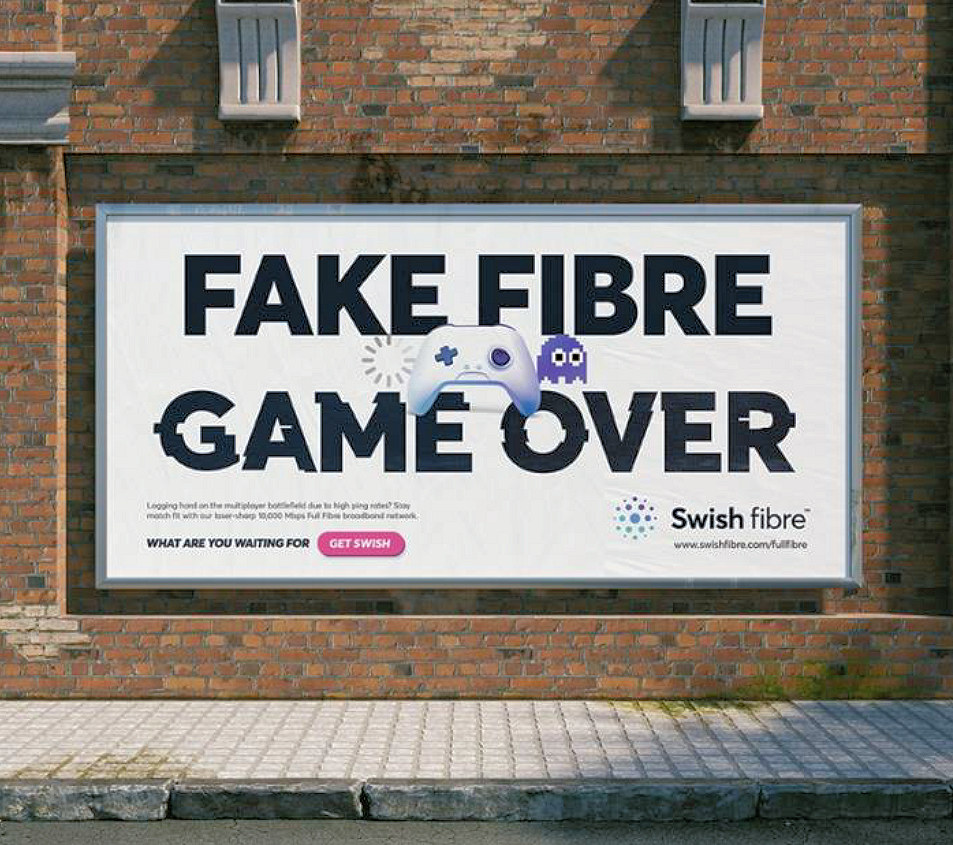Swish Fibre Complain to ASA Over BT’s Use of Fibre Broadband Terminology
Alternative UK ISP Swish Fibre has continued their “fake fibre” related advertising feud with BT today after they lodged a retaliatory complaint with the Advertising Standards Authority (ASA), which objected to the “confusing” use of the term “fibre broadband” in the incumbents marketing for their “part-fibre” (FTTC) products.

The situation began in July 2021, after Swish launched a new advertising campaign (here), which saw them place a number of billboard posters around the country (see top). The posters “playfully” tried to set their own full-fibre broadband service apart by using the “Fake Fibre” phrase to call out significantly slower and less reliable part-fibre services (e.g. FTTC / VDSL2), which still use slow copper lines to connect homes from a street cabinet.
However, Swish’s original campaign didn’t do a great job of defining “Fake Fibre“, which we previously remarked could still make it difficult for regular consumers to understand the differences. As a result, some people may incorrectly end up viewing the term as extending to rival FTTP ISPs too. On top of that, it ignored that some hybrid fibre networks (e.g. Virgin Media and FTTB ISPs) can deliver gigabit speeds. All of this risked creating more confusion.
In response, BT lodged a complaint with the ASA to challenge Swish’s adverts (this is ongoing), which it perhaps did partly in the knowledge that the advertising watchdog had long resisted – quite successfully – attempts to change the situation around the use of “fibre broadband” terminology in adverts for slower hybrid fibre products (here).
Sensing an opportunity, Swish then comically responded by launching a new take on their poster campaign, which introduced the word “Censored” (see below) as a way of alluding to BT’s resistance to its earlier “Fake Fibre” messaging.

Now Swish has opted to take their dispute further and has lodged their own complaint against BT’s use of “fibre broadband” on FTTC products with the ASA, which they note is often also referenced using similar terminology – “Superfast Fibre Broadband“, “Ultrafast Fibre Broadband” and “Faster Fibre broadband“, amongst others.
Back in 2017, fellow alternative network provider CityFibre challenged the ASA on this matter, but the case was dismissed by the courts. However, Swish points out that the market has changed dramatically since then and is now rapidly turning to FTTP methods, thus the ISP claims to be “rekindling the fight by pledging to educate the nation on Fake Fibre once and for all and [to] reverse years of misleading advertising.”
The focus here is clearly on FTTC (VDSL2), which is perhaps to avoid the murky waters of conflict around gigabit-capable FTTB and Hybrid Fibre Coax DOCSIS 3.1 networks. But the mention of download speeds maxing out at 80Mbps does overlook that G.fast is also an FTTC style technology and can max out at 330Mbps download and 50Mbps upload, albeit only in ideal circumstances on Openreach’s network.
Despite this, Swish claims there is now increasing evidence that consumers “struggle to differentiate between part-fibre broadband and state of the art full-fibre broadband,” such as the recent WIK Consult report for CityFibre. WIK’s study found that 52% of respondents claimed to have a Full Fibre service, despite only 20% of respondents living in areas where that was available at the time.
A recent report from the Gigabit Take-Up Advisory Group (GigaTAG) also warned about similar confusion and called for it to be addressed via a new labelling system (here), although the Government has yet to fully respond to the report’s recommendations. This was seen as important given the Government’s new £5bn Project Gigabit initiative, which could suffer if strong take-up doesn’t follow deployment.
Win or lose, all of this will perhaps partly be seen as another clever way of generating publicity for Swish Fibre’s build. But it will also, once again, force the ASA to tackle an awkward and uncomfortable issue that has previously resulted in plenty of criticism over the watchdog’s decision-making.



.png)
No comments: